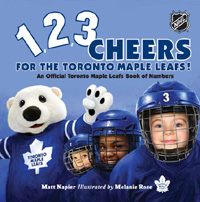| ________________
CM . . .
. Volume XXIII Number 13. . . .December 2, 2016

 |
1, 2, 3 Cheers for the Toronto Maple Leafs! An Official Toronto Maple Leafs Book of Numbers.
Matt Napier. Illustrated by Melanie Rose.
Toronto, ON: FENN/Tundra Books, 2016.
32 pp., hardcover & ebook, $21.99 (hc.).
ISBN 978-1-77049-801-3 (hc.), ISBN 978-1-77049-803-7 (ebook).
Kindergarten-grade 6 / Ages 5-11.
Review by Dave Jenkinson.
*** /4
|
| |
|

excerpt:
3
Did you know there have been THREE:
team names in Toronto history?
The Maple Leafs, but before that,
the Toronto Arenas and the St. Pats
In 1919, the Toronto Arenas became the St. Pats, winning the Stanley Cup in 1922. In 1927, Conn Smythe took over management of the team, and it was renamed the Maple Leafs. Smythe said the badge represented “pride, honour and courage” and served as a reminder of the sacrifices made by Canadian soldiers, who wore the maple leaf on their uniforms, in World War.
With the Toronto Maple Leafs about to celebrate their one-hundredth anniversary in 2017, 1, 2, 3 Cheers for the Toronto Maple Leafs! serves as an excellent “gift” for the team and its young fans. As the 1, 2, 3 in the title suggests, the work is, in part, a counting book with the focal numbers running from 1-15 before jumping to 20, 25 and 30 and then proceeding by 10s to 100. With three double-page spread exceptions, each number is treated in just a single page. The top two-thirds of a page are occupied by one of Rose’s realistically rendered and detailed illustrations while the bottom third contains Napier’s two-part text that has been placed over a skate-scarred ice background. As can be seen in the “excerpt”, Napier’s text consists of a four-line poem plus a few sentences of prose, the contents of which is information about the Leafs that connects to the page’s number. As the text for number 2 explains, the team’s colours are white and blue, and beginning with the endpapers, these two colours predominate throughout the book.
Since the book’s organization is numerical, there is no logical structure to its largely historical content which includes individual and team achievements. An example of the former would be Darryl Sittler’s NHL record 10 points in a single game while an instance of the latter is Toronto’s 13 Stanley Cup Championships. Overall, 1, 2, 3 Cheers for the Toronto Maple Leafs! does work as a counting book as the “items” to be counted are generally clear. 2 presents a problem, though, as the text is about the team’s two uniform colours while the “action” illustration shows seven players from two teams involved in a game at Air Canada Centre. There is also a bit of a mismatch between the illustration for 12 and its two-part text. Napier’s poem speaks to 12 banners hanging in the rafters of Air Canada Centre, banners which honour legendary Leafs, and Rose’s illustration does show 12 such banners. Napier’s prose text, however, says “A total of eighteen Leafs have been honoured this way...”, and the text goes on to name all 18. With 14, Rose engages in a bit of cheeky “product placement” as her illustration shows a young Leafs fan in his bedroom with all 14 pieces of his hockey equipment assembled On his bedside table can be seen a copy of M is for Maple Leafs, a book which just happens to have been illustrated by Melanie Rose.
While I can recommend that 1, 2, 3 Cheers for the Toronto Maple Leafs! be purchased by school and public libraries, I do have two concerns. Counting books are usually associated with the preschool crowd, but this book’s prose contents will not be available to that audience unless they have access to an intermediary who can read it to them. The factual content of the book would more naturally appeal to an older audience, children (and even teens and adults) who have followed the Leafs for a number of years. However, older children might avoid the book because of the 1, 2, 3 in its title and the illustration of three very young children on its cover. While 1, 2, 3... loosely belongs to the category of the normally desired “hockey” book, older readers’ first impressions may be that it’s a “baby” book, and, therefore, something to be avoided around peers. My second concern relates to the book’s overall design, one which seems to have been created by Sleeping Bear Press some decade and a half ago, i.e. an alphabet or counting book that has a subject focus and which includes realistic artwork as well as poetry and prose content. Frankly, the poetry, at its best, is weak and often forced sounding. Readers would be better served if the poetry was eliminated and replaced by more prose content.
Recommended.
Dave Jenkinson, CM’s editor, lives in Winnipeg, MB, home of the NHL’s Winnipeg Jets, and he is certain that he is joined by many others who disagree with the opening two lines of Napier’s poem connected to 1: ONE team stands above the rest:/the Maple Leafs are the league’s best.

To comment
on this title or this review, send mail to cm@umanitoba.ca.
Copyright © the Manitoba Library Association. Reproduction for personal
use is permitted only if this copyright notice is maintained. Any
other reproduction is prohibited without permission.
Next Review | Table of Contents For This Issue - December 2, 2016
CM Home | Back Issues
| Search
| CM Archive
| Profiles Archive
|
